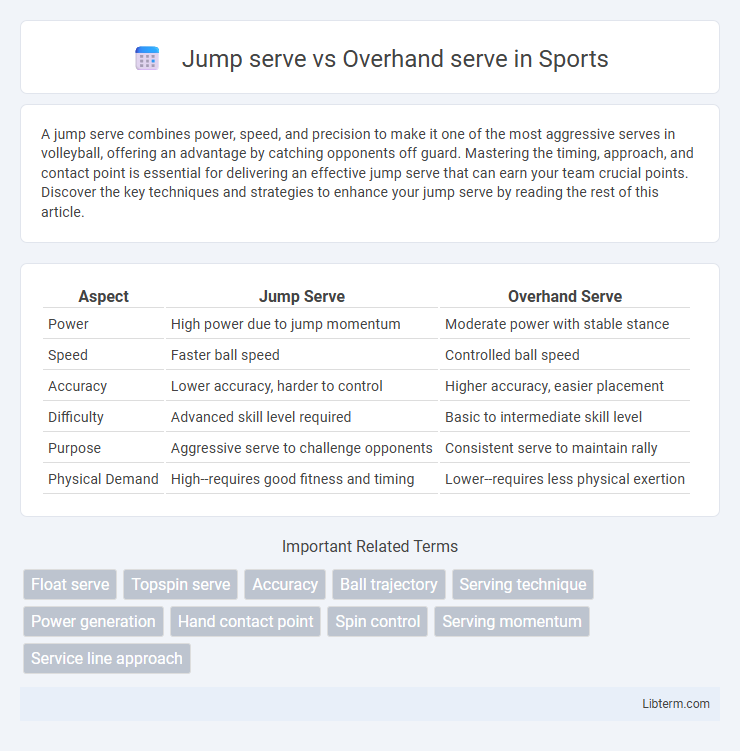A jump serve combines power, speed, and precision to make it one of the most aggressive serves in volleyball, offering an advantage by catching opponents off guard. Mastering the timing, approach, and contact point is essential for delivering an effective jump serve that can earn your team crucial points. Discover the key techniques and strategies to enhance your jump serve by reading the rest of this article.
Table of Comparison
| Aspect | Jump Serve | Overhand Serve |
|---|---|---|
| Power | High power due to jump momentum | Moderate power with stable stance |
| Speed | Faster ball speed | Controlled ball speed |
| Accuracy | Lower accuracy, harder to control | Higher accuracy, easier placement |
| Difficulty | Advanced skill level required | Basic to intermediate skill level |
| Purpose | Aggressive serve to challenge opponents | Consistent serve to maintain rally |
| Physical Demand | High--requires good fitness and timing | Lower--requires less physical exertion |
Introduction to Volleyball Serving Techniques
The jump serve in volleyball combines power and height to generate a fast, aggressive serve that challenges the receiver's timing and positioning, often resulting in aces or weak returns. In contrast, the overhand serve emphasizes control and consistency, making it ideal for beginners and strategic play by allowing precise ball placement over the net. Mastering both jump serve and overhand serve techniques enhances a player's versatility and effectiveness in competitive matches.
What is a Jump Serve?
A jump serve is a powerful volleyball technique where the player tosses the ball high, jumps, and strikes it at the peak of the jump, generating increased speed and spin for a more aggressive and unpredictable serve. This serve combines elements of an overhand serve but adds vertical momentum, making it harder for opponents to receive and control. The jump serve's effectiveness lies in its ability to create a faster ball trajectory and greater serving range compared to traditional standing overhand serves.
What is an Overhand Serve?
An overhand serve in volleyball is a powerful technique where the player tosses the ball overhead and strikes it with the hand above the shoulder level to send it over the net. This serve allows greater control, accuracy, and speed compared to an underhand serve, making it a fundamental part of competitive play. It forms the basis for more advanced serves like the jump serve, offering consistent placement and effectiveness in starting offensive plays.
Key Differences Between Jump Serve and Overhand Serve
The jump serve generates significantly higher ball velocity and spin due to the added momentum from the player's jump, making it more aggressive and difficult to return compared to the overhand serve. Overhand serves emphasize control and precision, allowing for strategic placement and consistent accuracy, while jump serves rely on power and timing for maximum impact. Jump serves require advanced athleticism and coordination, whereas overhand serves are more accessible and commonly used by players at all skill levels.
Power and Speed Comparison
Jump serves generate higher power and faster ball speed due to the added momentum from the player's vertical leap, often exceeding 60 mph in competitive play. Overhand serves, while typically more controlled, deliver less velocity, averaging between 40 to 50 mph but provide greater accuracy for tactical placement. The jump serve's explosive movement allows for enhanced power, making it ideal for aggressive play, whereas the overhand serve balances speed with precision.
Accuracy and Control Factors
Jump serves generate higher ball speed and power but can sacrifice accuracy due to the complex timing and increased body movement required. Overhand serves offer greater control and consistency by allowing more precise ball contact and stable body positioning. Players aiming for accuracy often prefer overhand serves for their reliability in placing the ball strategically within the opponent's court.
Situational Advantages of Each Serve
Jump serves deliver higher velocity and increased ball spin, making them ideal for aggressive play in competitive matches where powerful serves can disrupt the opponent's reception. Overhand serves provide greater control and consistency, benefiting beginners or situations requiring precise placement to exploit specific weaknesses in the opponent's lineup. Selecting between jump serve and overhand serve depends on game context, player skill, and strategic positioning to maximize scoring opportunities.
Skill Level and Training Requirements
The jump serve demands advanced skill level and explosive power, requiring intensive plyometric training and precise timing to maximize serve speed and accuracy. The overhand serve suits beginners to intermediate players, emphasizing fundamental technique and consistent ball toss, making it essential to develop muscle memory through repetitive practice. Mastery of the jump serve offers higher point-winning potential but necessitates rigorous strength and coordination drills, whereas the overhand serve prioritizes control and reliability in gameplay.
Common Mistakes and How to Avoid Them
Common mistakes in jump serves include improper timing of the toss and lack of explosive leg drive, which reduces power and accuracy. In overhand serves, players often fail to fully extend their arm and follow through, leading to inconsistent ball control and weaker serves. To avoid these errors, practice precise toss placement, engage core and leg muscles for jump serves, and ensure complete arm extension with a smooth follow-through during overhand serves.
Choosing the Right Serve for Your Game
Choosing the right serve, such as a jump serve or overhand serve, depends on your skill level, power, and control preferences in volleyball. The jump serve offers increased speed and topspin, making it ideal for aggressive players seeking to pressure opponents and score aces. In contrast, the overhand serve provides greater accuracy and consistency, recommended for beginners or players focusing on steady ball placement and minimizing errors.
Jump serve Infographic

 libterm.com
libterm.com